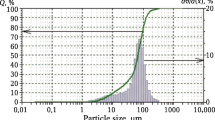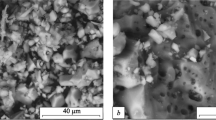Properties, production methods, and fields of application for finely dispersed activated α-aluminum oxide are considered. Information about international and Russian manufacturers of reactive alumina used in the production of engineering ceramics and low-cement refractory cast mixes is presented. Characteristics of reactive alumina produced by different companies are provided.




Similar content being viewed by others
References
H. A. Wriedt, “The Al-O (aluminum-oxygen) system,” Bulletin of Alloy Phase Diagrams, 6(6), 548 – 553 (1985).
Springer Handbook of Condensed Matter and Materials Data, ed. by W. Martienssen, H. Warlimont, Springer, Berlin (2005).
A. S. Povarennykh, Mineral Hardness, Izd. AN USSR, Kiev (1963).
CRC Handbook of Chemistry and Physics; ed. byW. M. Haynes; 97th ed., CRC Press, Boca Raton (2017).
S. Penn and N. Alford, “Ceramic dielectrics for microwave applications,” Handbook of Low and High Dielectric Constant Materials and their Applications. Academic Press, San Diego (1999).
A. M. Abyzov, Aluminum oxide and aluminum oxide ceramic (Review), Part 1. Properties of Al2O3 and industrial production of fine Al2O3, Novye Ogneupory, No. 1, 16 – 23 (2019).
E. S. Dukin, N. A. Popova, and N. I. dvizhkova, “Strong ceramics based on aluminum oxide and zirconium dioxide,” Steklo Keram., No. 9, 25 – 30 (1993).
V. V. Smirnov and I. V. Sinitsa, “Corundum ceramic with low sintering temperature,” Ogneupory. No. 10. 7 – 9 (1994).
I. S. Kainarskii, É. V. Degtyareva, and I. G. Orlova, Corundum Refractories and Ceramics [in Russian], Metallurgiya, Moscow (1981).
A. V. Belyakov, “Structural ceramic technology,” VINITI Itogi Nauki Tekhniki, 1, 2 – 60 (1988).
D. A. Antonov, S. S. Pavlov, and N. A. Makarov, “Corundum ceramic for grinding bodies with reduced sintering temperature,” Contemporary methods of technology for creation and development of materials: Proc. XIII Internat. Sci.-Tech. Conf, 12 – 14 Sept. 2018, Minsk (2028). https://rep.bntu.by/handle/data/51806.
S. Ghose, C. Saigal, A. Maldhure, and S. K. Das, “Effect of reactive alumina on the physicomechanical properties of refractory castable,” Trans. Ind. Ceram. Soc., 72(2), 113 – 118 (2013).
Y. F. Hsu, S. F. Wang, and T.W. Cheng, “Effects of additives on the densification and microstructural evolution of fine Al2O3 powder,” Mater. Sci. Eng., 362, 300 – 308 (2003).
R. H. Hussey and J. Wilson Hussey, Advanced Technical Ceramics Directory and Data Book Chapman and Hall, London (1998).
A. M. Abyzov, “Aluminum oxide and aluminum oxide ceramic. (Review). Part 2. Overseas production of aluminum oxide ceramic. Technology and study in the field of aluminum oxide ceramic,” Novye Ogneupory, No. 2, 13 – 22 (2019).
A. M. Abyzov, “Aluminum oxide and aluminum oxide ceramic. (Review). Part 3. Russian producers of aluminum oxide ceramic,” Novye Ogneupory, No. 4, 20 – 28 (2019).
V. V. Martynenko, K. I. Primachenko, K. I. Kuschchenko, et al., “Study of rheological properties of alumina slips containing new dispersed and strengthening additives,” Zbir. Nauk. Prats. PAT UkrNDI vog. Im. A. S. Berezhneva, No. 116, 98 – 109 (2016).
V. V. Martynenko, K. I. Primachenko, K. I. Kuschchenko, et al., “Study of new froms of alumina with the aim of application for preparing highly refractory especially dense corundum ceramic by slip casting,” Zbir. Nauk. Prats. PAT UkrNDI vog. Im. A. S. Berezhneva, No. 117, 149 – 159 (2017).
V. P. Tarasovskii, A. A. Avgustov, A. Yu. Omarov, et al., “Compatrative analysis of the properties of aluminum oxide powder of different grades and ceramics based upon them,” Novye Ogneupory, No. 2, 40 – 43 (2019).
Yu. I. Komolikov, I. D. Kashcheeev, K. T. Zemlyanoi, and V. I. Pudov, “Properties of ceramic based on Al2O3 with addition of ultrafine Al2O3 powder synthesized by an electrochemical method,” Novye Ogneupory, No. 7, 28 – 30 (2019).
S. Berrin Gürel and Altun Akin, “Reactive alumina production for the refractory industry,” Powder Technology, No. 196, 115 – 121 (2009).
M. Schnabel, A. Buhr, R. Kockegey-Lorenz, et al., “Benefit of matrix alumina and modern dispersing systems in low cement castables,” Interceram - Refractories Manual, 63(6), 281 – 285 (2014).
A. K. Samanta, S. Satpathy, S. Adak, and A. K. Chattopadhyay, “Studies on flow behavior of low cement castables in presence of different reactive alumina and microsilica,” 56th International Colloquium on Refractories “Refractories for Industrials” (2013).
M. Bugajski, G. Moertl, and M. Hoesler, Pat. DE4125511C2. Free-flowing refractory casting compound, 15.09.1994.
R. Stonis, I. Pundiene, V. Antonovich, et al., “Study of the effect of replacing microsilica within heat-resistant concrete composition by additive based on metakaolin,” Novye Ogneupory, No. 6, 43 – 48 (2013).
B. Myhre, “Microsilica in refractory castables how does microsilica quality influence performance?” Proc. of 9th Bienial Worldwide Congr. on Refractories (2005).
The Nabaltec Company. https://nabaltec.de/en/company.
Almatis Premium Alumina. https://www.almatis.com/market-en/refractories.
AO Borovich Refractory Combine. http://aobko.ru/refractories.
J. Kiennemann, E. Chabas, C. Ulrich, and D. Dumont, “The role of granulometry and additives in optimising the alumina matrix in low cement castables,” Refractories Worldforum, No. 9, 77 – 82 (2017).
Yu. E. Pivinskii, Rheology of Dispersed Systems, HCBS, and Ceramic Concretes. Elements of Nanotechnology in Materials Science [in Russian], Politekhnika, SPb (2012).
Ch. Donzen and D. Janousch, “Viscosity changes of an alumina based castable during mixing and the effect of bimodal reactive alumina,” Refractories Worldforum, No. 3, 32 – 37 (2021).
T. Khalil, J. Bossert, A. H. Ashor, and F. Abou EL-Nour, “Preparation, characterization and application of alumina powder produced by advanced preparation techniques,” Seventh Conference of Nuclear Science and Applications, Cairo, Egypt (2000).
C. B. Reid, J. Forrester, H. J. Goodshaw, and G. J. Suaning, “Study in the mechanical milling of alumina powder,” Ceram. Int., 34(6), 1551 – 1556 (2008).
M. A. Wojcik, T. Gajda, J. Plewa, et al., “Effect of selected parameters on grinding process of alumina in the rotary-vibration mill,” Fizykochemiczne Problemy Mineralurgii, No. 31, 115 – 124 (1997).
T. Ban, K. Okada, T. Hayashi, and N. Otsuka, “Mechanochemical effects for some Al2O3 powders of dry grinding,” J. Mater. Sci., No. 27, 465 – 471 (1992).
Author information
Authors and Affiliations
Corresponding authors
Additional information
Translated from Novye Ogneupory, No.3, pp. 16 – 22, March, 2022.
Rights and permissions
Springer Nature or its licensor (e.g. a society or other partner) holds exclusive rights to this article under a publishing agreement with the author(s) or other rightsholder(s); author self-archiving of the accepted manuscript version of this article is solely governed by the terms of such publishing agreement and applicable law.
About this article
Cite this article
Trubitsyn, M.A., Volovicheva, N.A., Furda, L.B. et al. Research in the Area of Preparing Activated Alumina. Part 1. Methods for Preparing Reactive Alumina. Refract Ind Ceram 63, 130–136 (2022). https://doi.org/10.1007/s11148-022-00694-w
Received:
Published:
Issue Date:
DOI: https://doi.org/10.1007/s11148-022-00694-w




